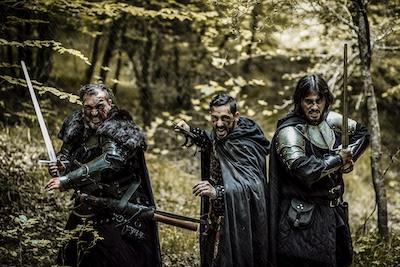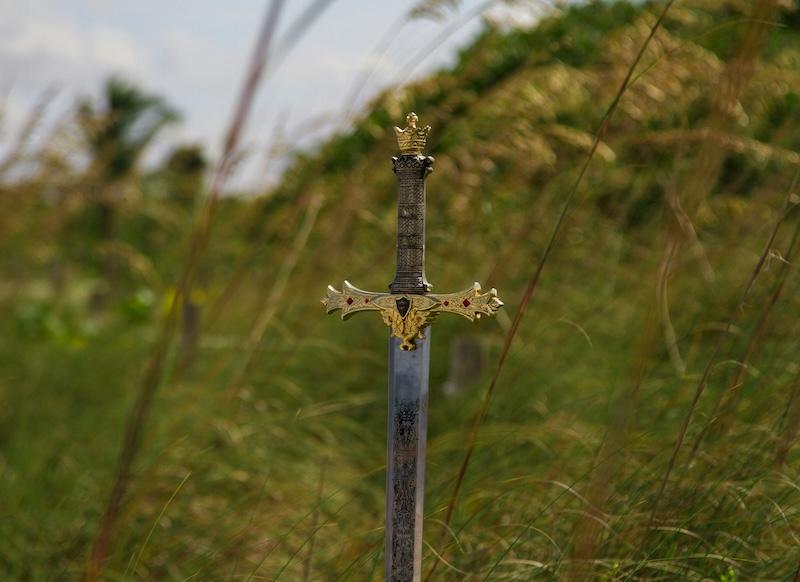Andrew Knighton takes his mind back to Fantasycon 2024, consults his notes, and brings us this debrief from the panel on Arthurian legends.

On the Saturday of last year’s Fantasycon, I found myself pondering retellings of very different types. After discussing Muppet movies in the morning, I headed over to a panel on the legend of King Arthur, one of those legendary spaces that’s been retold many times. Up to talk about the once and future king were Chris Hawton, Juliet E McKenna, Thomas D Lee, Russell Smith, and David Cartwright, all of whom had interesting things to say.
Why This Story?
The conversation started with David asking why we keep coming back to this particular set of legends.
As Chris pointed out, Arthur acts as a useful metaphor to be reused for different times, for example in the way that Kieron Gillen and Dan Mora’s Once and Future uses it to explore rampant nationalism. Though the dark side of this is that Arthuriana can be used for rampant nationalism, as Geoffrey of Monmouth and King Henry VIII did. We have to be careful with this mythology, given how easily it can tread that ground, and Thomas argued that this makes it important to keep exploring the myths and to write stories countering a cruel perspective.
These shifting takes on nationalism nicely illustrate a point Russell then made – that King Arthur gets rewritten in every generation to address that generation’s issues. For him, this mythology raises the important question of “who do you serve?†and it turns out that these myths themselves serve a range of different causes.
While some people might see that as an argument to look only forwards, Juliet pointed out how it also makes us look back. It’s important to go back to the source material and to more recent retellings, to consider who’s been included and excluded. When writing The Cleaving, gaps she noticed included a lack of recent work exploring the weirder side of Arthuriana, and the lack of focus on women. She wrote her book to explore what those women were doing while pushed off unseen into the wings (and for more on that book’s smart intertextuality, I have a whole other post here).
Arthuriana and Religion
Next, David raised the surprising number of middle eastern knights in the Arthurian mythos, and asked what perspective they can add.
Russell explained that this can be a useful way to turn the story into different sorts of immigrant narratives. For comparison, he talked about how the same people get very different narratives in the mythology around fighter pilots in the First World War. Sometimes described as knights of the sky, they were highly glamourised figures whose larger-than-life personalities and impressive achievements got exaggerated for propaganda. Those stories of a noble, honourable brotherhood were a long way from the deteriorating reality of aerial combat and its brutally high body count.
From this, Thomas got into one of the most important features of this mythology – that there is no original Arthurian story, it’s all fan fiction reinventing past times. At various points in the Middle Ages, writers jammed features of their own time into their concept of the past. Critically, the medieval accounts that modern writers are building upon were written after the crusades but set in a pre-Islamic era. This makes the Saracens in their stories an anachronism, but those writers didn’t care about that.

As Russell pointed out, this brings up an issue any writer has to decide on when writing Arthurian fiction – how big a part do they want religion to play in your story? In his view, you have to either go all in or just skim over it, this isn’t a topic that you can half-arse.
(Photo by Gioele Fazzeri on Unsplash)
Differing Myths
This led into a wider conversation on how the myths vary. As Juliet said, until relatively recently the past was kept alive by living memory, and most of the past lay outside those memories. Myths were created as descriptions of that pre-memory time, but using the familiar features of the artist’s own era. Myth space is both infinite and close to hand, and as Russell pointed out, human memory isn’t as consistent as we think, further distorting the story.
The results are different for different mythologies. Chris argued that the Arthurian myth can tell more varied stories than for example Robin Hood, because the Arthuriana features such a wide variety of material. And part of that material is the once and future king, an immensely powerful idea – though if he’s meant to turn up in times of national crisis, where is he now?
That said, Robin Hood also gets reinvented, and Russell used an example from that to show how quickly myths evolve. The 1980s TV show Robin of Sherwood was the first version to add a Saracen character to that mythology, and others have repeatedly used it since, to the point where it’s become standard.
Thomas pointed out how much this is like Arthuriana, where elements like Lancelot came from outside to become fundamentals of the mythology.
Which Knights Get Cut?
The flexibility of the mythology led into Chris’s next question. When you separate the knights from their setting you can choose what to keep and to remove, so what would the panellists want to ditch from the mythology?
Thomas argued that you can’t interrogate the problematic stuff without including it. Keeping in toxic masculinity gives you a chance to battle it. As a counterpoint, Russell suggested that you can tackle these problems by ditching the toxic stuff to tell a more positive story, like Magic Mike XXL presenting a non-toxic version of masculinity.
Speaking of gender, Juliet wanted to get rid of the soft focus romantic Guineveres who kept cropping up in the 1990s.
Chris wanted to keep the Avengers-style round table with a lot of characters you can dip in and out of, like Grant Morrison’s work on Batman, dipping into different bits of the mythos to tell different stories. Though he would ditch the jousting.
This led to a couple of interesting recommendations for books playing with those different characters – Sword Stone Table, an anthology of diverse stories putting those characters in different settings, and The Dust of the Red Rose Knight by James Bennett, a gleefully queer take showing the different things the mythos can do.
(No more soft-focus Guineveres like in this photo by Timothy Dykes on Unsplash)

David pointed out a source of variety that people often overlook – the number of characters who have super powers in the original legends, like Sir Maroc as a werewolf. As Juliet pointed out, they’re not monsters if they’re on your side. Thomas compared this with the Avengers, the legends bringing in characters that audiences knew from their own stories, which as Juliet said is a great shortcut in storytelling – you don’t have to explain who Mordred is if readers already know.
The Once and Future Round Table
Having talked about the past of Arthurian legends, the panel finished by talking about their present and future – what takes on the story the panellists have enjoyed, and what they’d still like to see.
Juliet recommended The Book of Gaheris by Kari Sperring as a good version – apparently Sperring is also now working on a modern retelling. She’s an author who has fun with the legend, which you need to do if you’re going to write it.
Thomas wanted to see new weird Arthuriana – not worrying about finding the historical truth, just playing with the pieces.
Chris wanted to see Arthur as the villain, maybe from Mordred’s point of view. Along these lines, Juliet recommended The Royal Changeling by John Whitbourn, in which Arthur comes back as an undead changeling.
Russell and Thomas recommended By Force Alone by Lavie Tidhar, which explores anti-immigrant rhetoric.
This was clearly just the tip of an iceberg the panellists were ready to reveal. After centuries of writing, there are enough Arthurian stories to keep you reading for years. In the meantime, the panel provided us all with plenty of ways to think about the myth, and inspiration for more versions to come.



